Even though many elements of the suit as we know it today have remained unchanged since its inception, there are certainly differences in the details of a suit from 2020 compared to a suit from the 1980s or 1940s. To understand those differences, let’s trace the history of the suit, from its origins to the modern era.
- What Exactly Is A Suit?
- Beau Brummell & The French Revolution
- The Victorian Era
- The 20th Century
- The Edwardian Era (1910s)
- The Roaring 1920s
- The Golden Age of Classic Menswear (1930s)
- The 1940s
- The 1950s
- The 1960s
- The 1970s
- The 1980s
- The 1990s
- The New Millennium
- The 2000s
- The 2010s
- Conclusion – The Suit Today
- Outfit Rundown
What Exactly Is A Suit?
The term “suit” is derived from the French term suivre. which means “to follow.” In other words, the jacket follows the pants or vice versa. So, a suit is a combination of a jacket and a pair of pants in a matching fabric. It’s not just the color of the garments that is the same, but also the fabric composition.
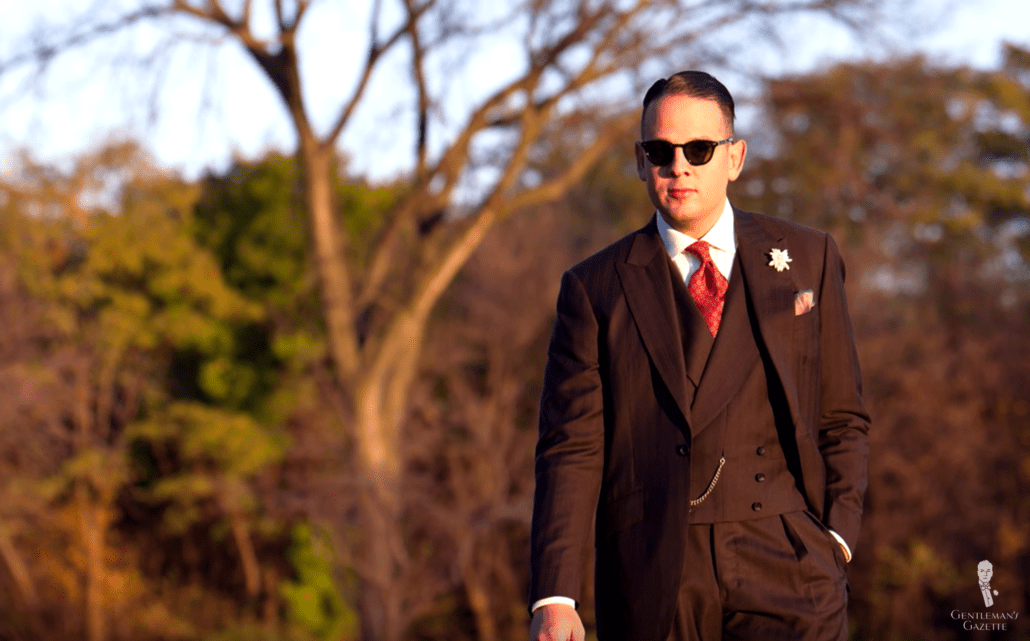
Beau Brummell & The French Revolution
Like many aspects of classic menswear, the origins of the suit can also be traced back to Beau Brummell. He was the prototypical gent in 19th century England. Before Beau Brummell, menswear was heavily influenced by the French court, and evolved around heavily embroidered fabrics such as velvet, knee-breeches, and stockings. Beau Brummell replaced all of this with long trousers worn with boots, and a coat that didn’t have much ornamentation or color.
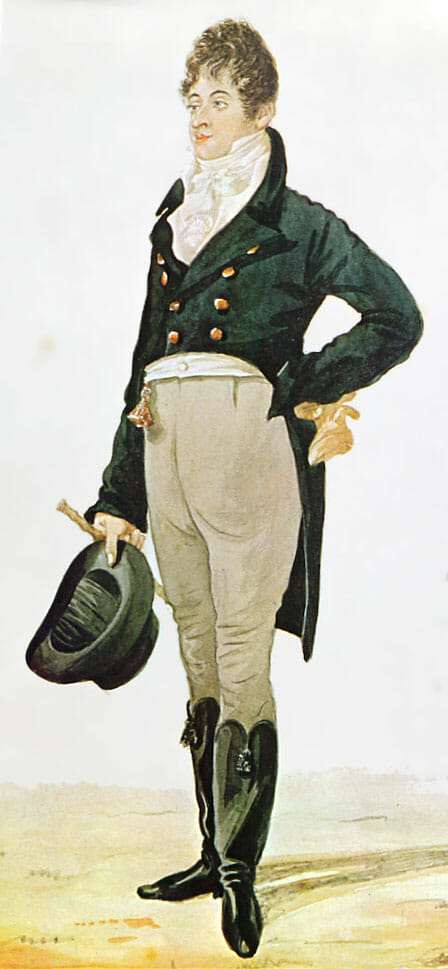
Frankly, Brummell may not have been the first one to simplify the classic French men’s wardrobe, because at that point in time, the more traditional dress had already become unpopular. French menswear was negatively associated with the French Revolution, and people who wore it were sometimes beheaded by the guillotine. Nevertheless, Beau Brummell definitely popularized the new, less ornamental style. While the top and the bottom of Beau Brummell’s outfits didn’t exactly match, the whole silhouette and the more muted color scheme laid the groundwork for the modern suit, as we know it today.
The Victorian Era
The Frock Coat
By the start of the Victorian era (which lasted from 1837 to 1901), the first and foremost garment a man would wear was a frock coat. It was basically a black coat that resembles modern overcoats. It had a single vent in the back and was either single- or double-breasted. In terms of length, it reached down all the way to the knees; that’s why it resembles an overcoat. While the single-breasted version of a frock coat was more common, the double-breasted version was more formal (and was also known as the Prince Albert).
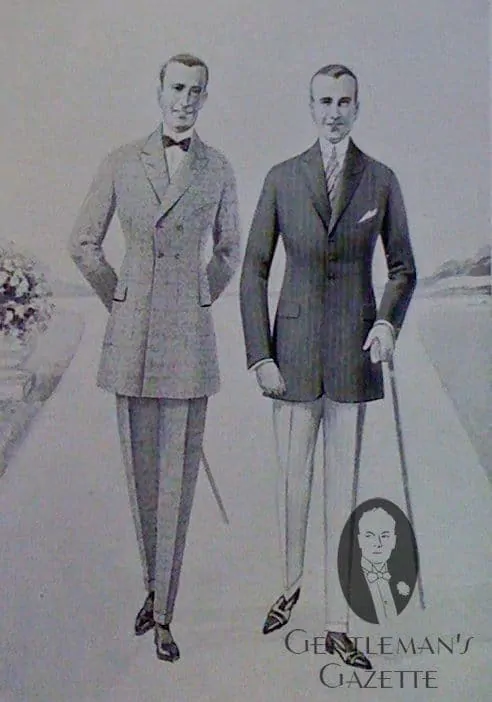
Later in the Victorian era, the frock coat basically split up into two different elements. On the one hand, we had the morning coat that kept the tails; on the other hand, we had the lounge suit which lost them. While the morning suit retained the length, it now had open quarters rather than the closed quarters of a frock coat, often had just a single button, and wasn’t double-breasted anymore.
At the time, it became the number one option for formal daywear–but in today’s world, it’s even more formal, and typically only worn at Royal Weddings or high society weddings. In England, you may still see the common man wearing a morning coat for his wedding, but in the US and outside of England, it’s typically just done in very certain circles, either by people who really appreciate classic men’s clothing or because they have a certain status in society.
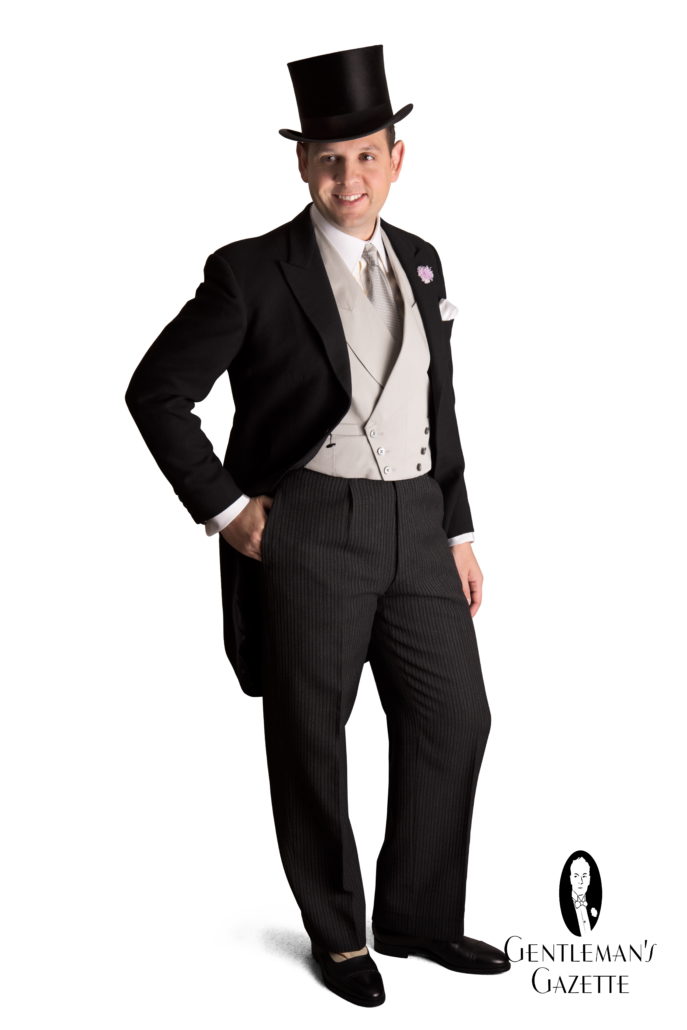
While frock coats and morning coats could technically be worn with matching a pair of trousers, more often, they were worn with contrasting trousers. Still in a darker color scheme but nevertheless, they weren’t made out of matching fabric. On the other hand, the lounge suit consists of a top and bottom of the matching fabric. Because of that, the lounge suit was also known colloquially as “dittoes.”
The Lounge Suit
The lounge suit was originally developed in the 1850s to the 1860s in Scotland. It was made out of heavier fabric and was meant to be a garment for casual outdoor occasions. Nowadays, in the mind of most people, a suit is a very formal garment, but during the Victorian era it was the opposite. It was a casual garment that was not meant to be formal at all.
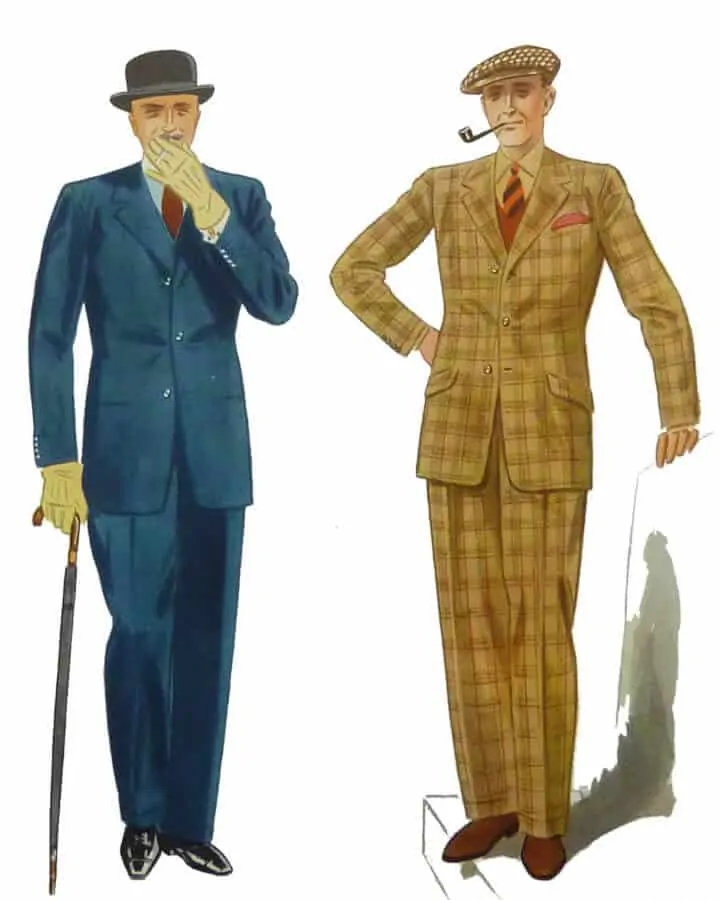
Specifically, the matching aspect of trousers and pants made it less formal, because frock coats and morning coats were worn with somewhat contrasting trousers. Another difference was obviously the length. It was a much shorter coat without the tails and was cut more sack-like without pronounced front darts.
As the name implies, the lounge suit was primarily a garment for the casual lounge, something to be comfortable in, especially in the British countryside. Of course, at the time, central heating was not the norm, and so suits were always worn with a vest or a waistcoat that was matching so you always had a three-piece suit.
The 20th Century
As we started the 20th century, the suit, as we know it today was pretty much developed. From that point on, the shape was defined, it was merely the details that changed. It could be the lapel width, the jacket length, the buttoning point, the height of the gorge, the type of fabrics that were used, and so on. Overall, it was just an adaptation to an existing model.
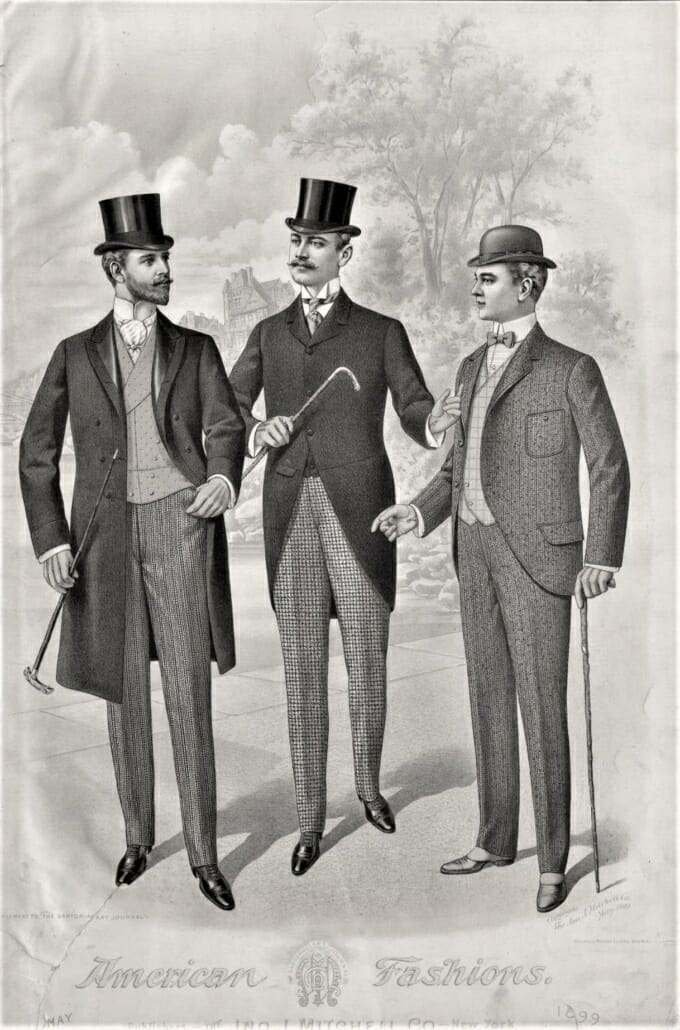
The Edwardian Era (1910s)
In the first decade of the 1900s, also known as the Edwardian era, the lounge suit persisted. It became more and more popular. The more formal frock coats and morning coats were still around, but were typically worn by older men, and lost ground very quickly.
If you’ve ever had a chance to touch a suit from the Edwardian era, you’ll notice that the fabric is extremely heavy and coarse. On the one hand, the fabric finishing wasn’t as refined as it is today, and on the other hand, it was quite expensive. Again, there was no central heating and because of that, suits had to be worn inside. Many households were still heated with coal, and cities were generally a dirty, sooty place to be. Because of that, the city suit was typically tailored out of darker colored fabric.
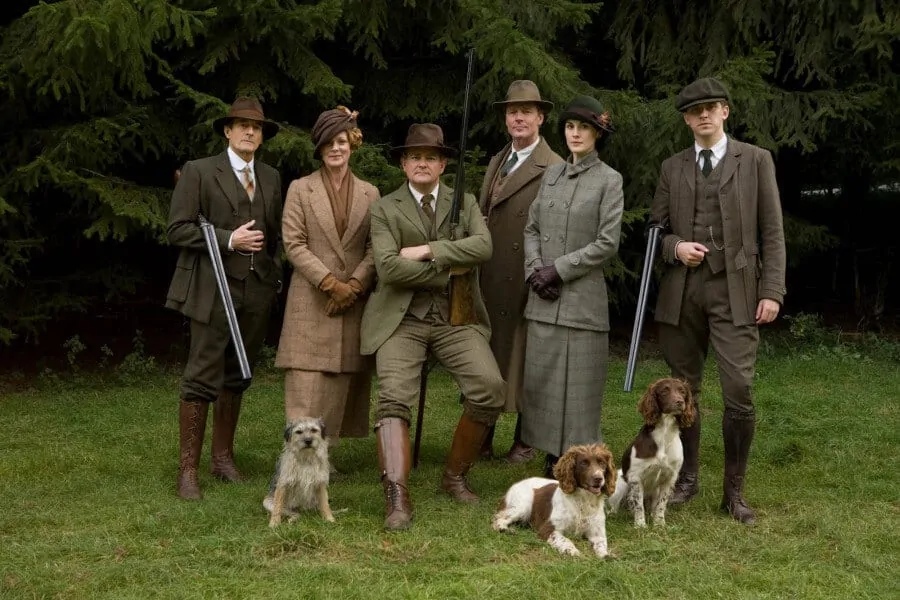
On the flipside, country suits typically had more patterns and brown tones in them. For example, if you watch the first episodes of Downton Abbey today, you can see the trend that country suits are less formal and more colorful than their city suit counterparts.
The Roaring 1920s
The 1920s were an exciting decade for the suit as it went from super slim to fuller towards the end. Right after World War I, the suit had a strong military influence. The jacket was cut trim, maybe slightly longer at a higher buttoning point, and trousers were quite slim with cuffs and relatively short. However, by the end of the decade, fashion-forward suits already had the precursor of the drape suit, which meant there was more fabric in the chest and also the pants were cut a little wider. Drape and the drape suit really became popular in 1930s England in the US.
During the ’20s, trousers all had a very high rise especially compared to today’s pants. All jackets were cut pretty tightly towards the beginning of the 1920s, towards the end, they had become wider in the shoulder with a bit more waist suppression, and in combination with the high-rise pants, one created a visual illusion of longer legs and a pronounced waistline.
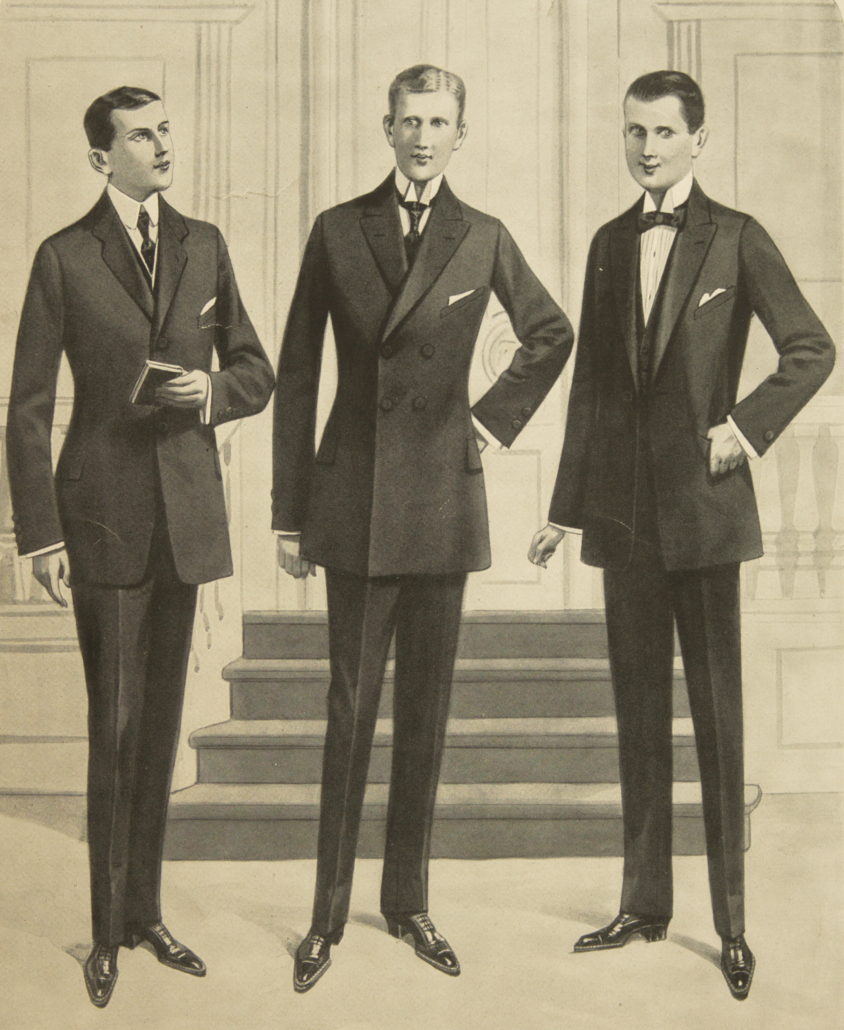
While the pant legs initially touched the sock, by the end of the decade, the most fashion-forward suits had an opening of 11.5 inches. However, it wasn’t a flare cut, it was a straight cut and sometimes even a tapered cut so there was lots of room in your trousers. If you want to get a better idea of this style in action, you may want to watch the series Jeeves and Wooster.
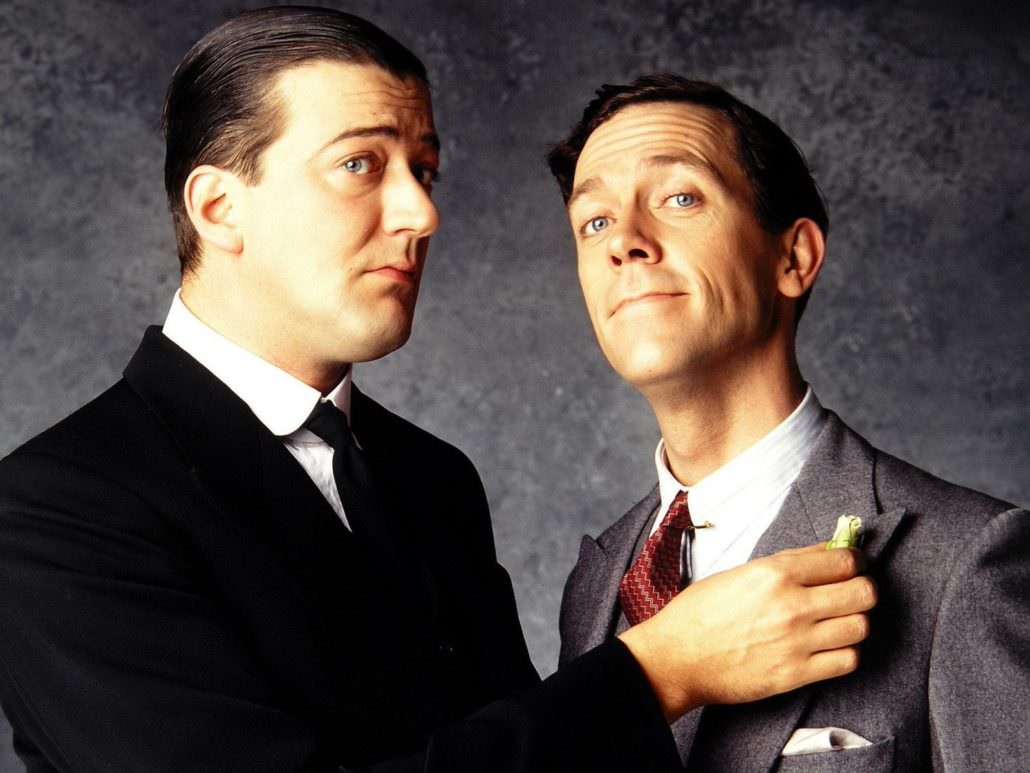
Because it was the roaring 20s, which is also known as the Jazz Age, the big difference in terms of suiting materials was that they were more stylish, there was more flash, there were more colors, more patterns, and everything was bit more lively compared to previous generations of suits. There was also an increasing interest in accessorizing their suits with, let’s say, pocket squares or shirts with collar pins. In the end, it was a rebellion towards the tradition of having dark suits and muted colors without bold patterns.
For example, if you watch the show Boardwalk Empire, you’ll see exactly what we mean. You see really loud suits in bold colors, stripes, and it’s just a very interesting time for the suit. Likewise, the Great Gatsby reflects this perfectly with his pink suit.
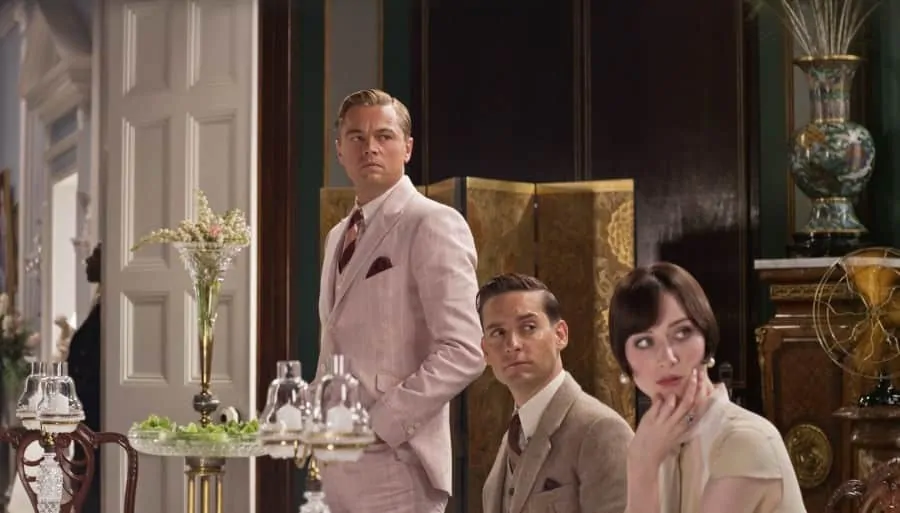
The 1920s were also known for the double-breasted waistcoat, which was typically worn underneath a single breasted jacket with notch lapels. Today, they would be considered quite unusual. If you see a double-breasted waistcoat, it typically features a jacket with a single or maybe two buttons and peak lapels. You also wouldn’t button the jacket, in order to show the double-breasted waistcoat.
The Golden Age of Classic Menswear (1930s)
The 1930s were characterized by a suit that had a heavy drape cut with a wide shoulder, a lot of waist suppression, high-rise trousers that were just cut very full and just tapered slightly towards the shoes. It was the number one style in England and in the US but also, places like Vienna.
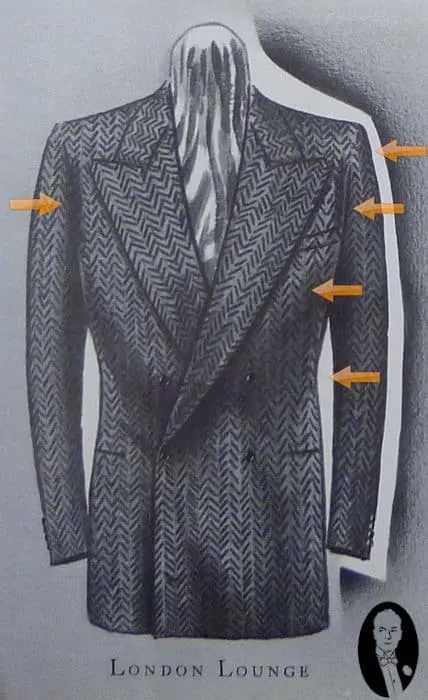
Jackets were typically a bit longer and had no vents in the back for an ideal clean line when you would stand. Also bear in mind, the fabrics were sold quite heavy so they draped really well and they didn’t wrinkle very much. The look was very masculine and it built the basis of a very heroic look on the silver screen. Just look at Cary Grant or Clark Gable who perfectly used the suit to underline their personalities in the movies.
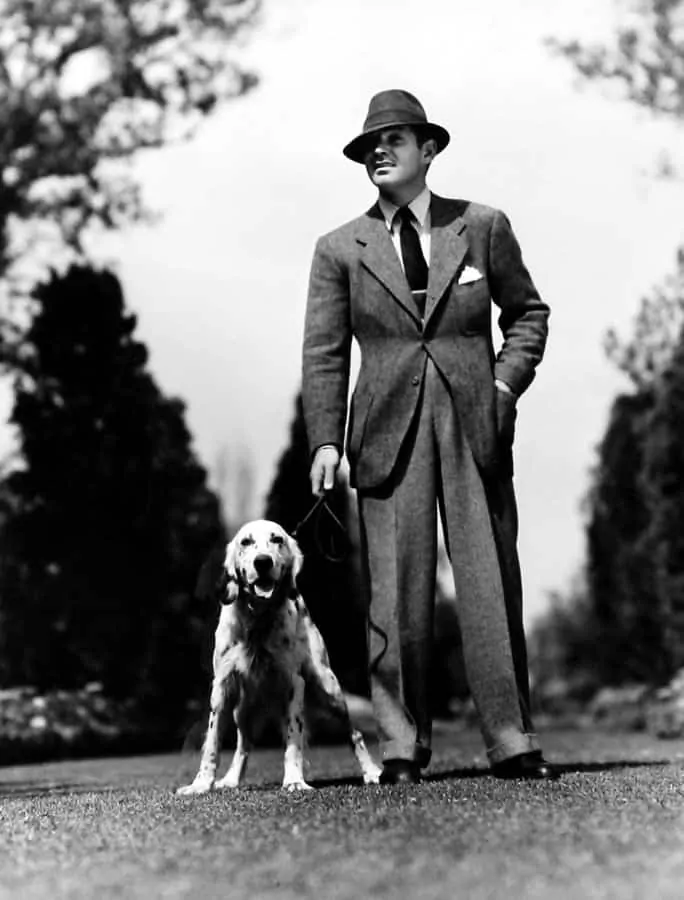
Overall, a 1930s drape style was a little more refined, more tapered towards the leg compared to the late ’20s suits. Even today, the 1930s are often referred to as the “golden age of classic menswear,” in big part because of the way the suits were designed. You can learn more about it by checking out our eBook, Gentlemen of the Golden Age.
The 1940s
In the following decade, the suit changed a great deal. World War II meant that everything had to be rationed, and so there was no more fabric for these elaborate full-cut large suits. Instead, the 1940 suits were characterized by minimalism. The gray flannel suit became the option of choice for professional everyday wear. It wasn’t double-breasted, but rather single-breasted, and it had narrow lapels and a very trim-cut trouser without cuffs, in order to save fabric.
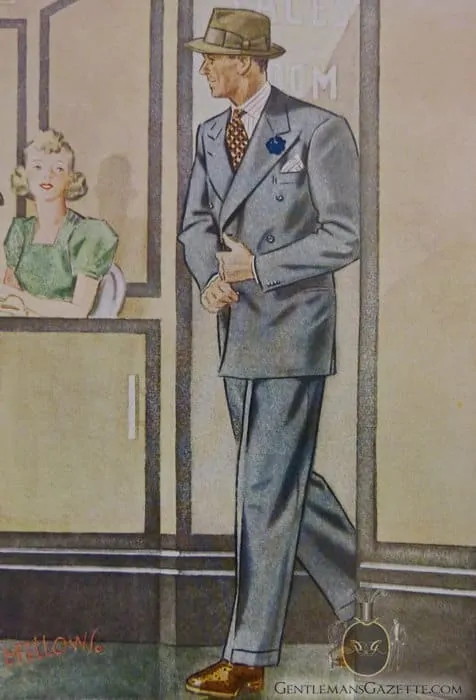
For the same reasons, waistcoats or vests became unpopular. If you look at the suit from the 1940s, it is very close to the fashion of a 2020 suit, because it’s lean, trim, and overall very slim. Of course, the fabrics were still a lot heavier than they are today and they also had a bit more texture than what you would get today.
The exception in the 1940s minimal suit was the rebellious Zoot suit. It was a product of the counterculture rebellion youth, particularly in African-American and Mexican communities. They had really baggy pants, a long jacket, and everything was oversized and excessive. The shoulders were super padded and often, people criticized it as being unpatriotic because it put your own idea of fashion beyond the rationing of fabric.
The 1950s
During the 1950s, the post-war rebellion definitely had an impact on the suit. To the end of austerity, some people went back to the suit style from before the war so lapels came wider, pants had pleats again, and it wasn’t as slim anymore.
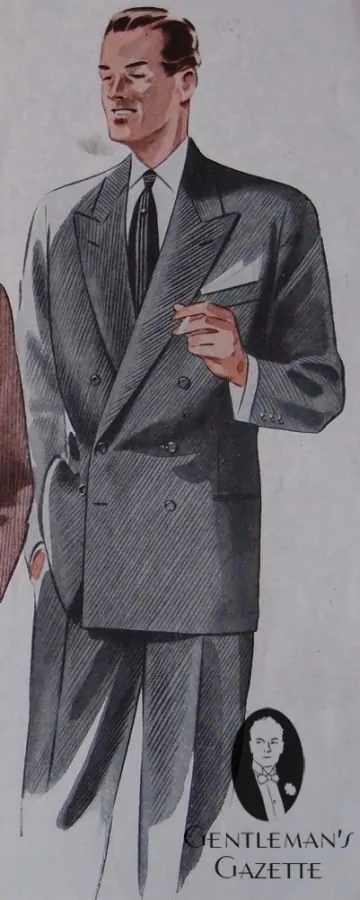
Pleated pants were particularly popular because they allow for a range of movement and more comfort and that, by the way, is still true today. The vest in a three-piece suit continued to decline because central heating was more or less well established at the time and so the need for extra heat inside had vanished. Again, it was a post-war period and just like after the 1920s when there was this post-war rebellion against the previous generation’s style, the same thing happened in the ’50s.
It wasn’t just the zoot suit but many other young men rebelled against the style of their fathers and grandfathers by wearing t-shirts or jeans or leather jackets. Another example of this rebellion, maybe so in a more subtle way, was the Ivy League style which was epitomized by the sack suit style jacket. It is usually defined by a three-roll-two jacket with a single center vent and pants without pleats.
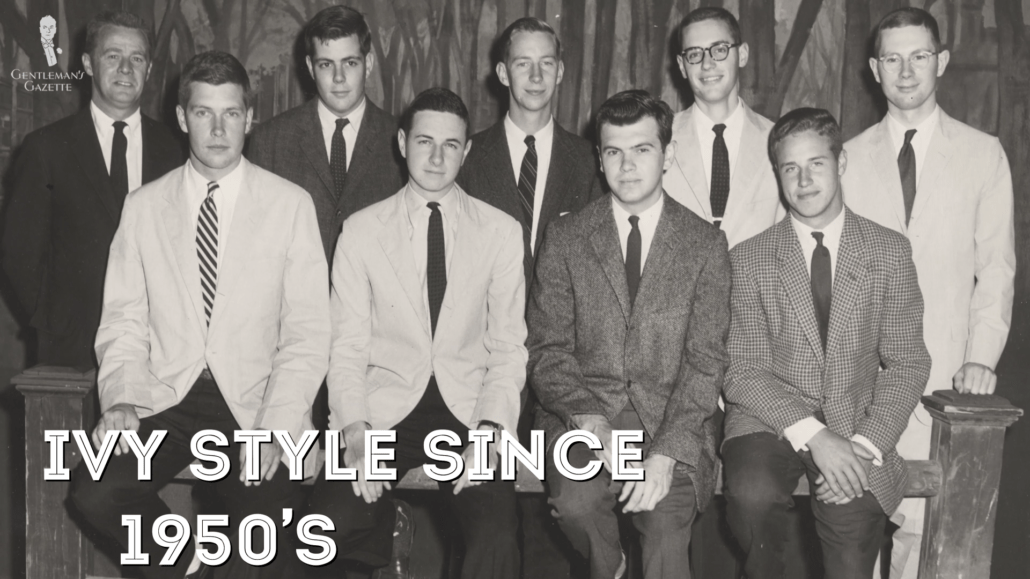
The other style of jacket was always single-breasted and had very little or no padding in the shoulders which made for a very natural silhouette which is more closely associated with Italy today but in fact, the Americans have done that for a long time too. This was a time when Brooks Brothers really dominated in American history and overall, the casualization of clothes also didn’t take hold of the suit so Ivy League style was characterized by combinations, more so than the suit. Yes, the suit was still around but sport coats have become more popular due to their increased texture and color variation.
At the end of the ’50s, we saw yet another subculture in suits known as the Mod suit. It was slim-fitting with narrow lapels. It was worn with narrow ties, non-pleated pants that were very thin and straight cut. For good examples of 1950 suits, you can look at Frank Sinatra or the Rat Pack, they really epitomized the style of the time.
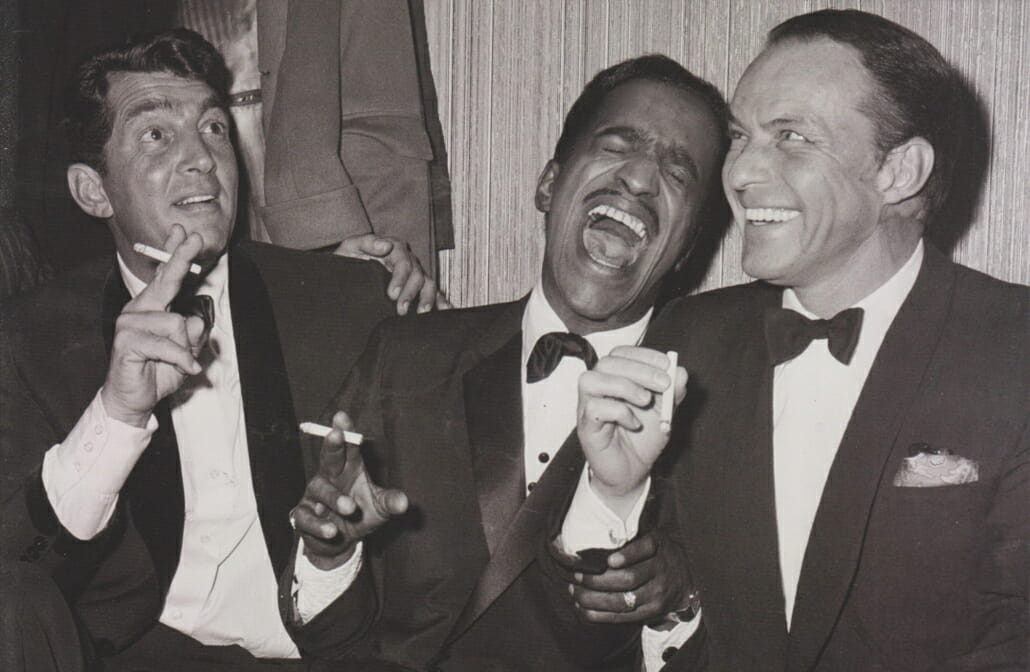
The 1960s
During the 1960s, the style of the ’50s was more or less extended when it came to suits. So you had closely fitting suits with some shoulder paddings that were worn with narrow ties. Trousers were rather narrow, a little more tapered towards the ankle and short so you wouldn’t see a break on the shoe. Even if there were cuffs or no cuffs, fabrics were still rather heavy and textured but they made some advancements and now added nylon and new artificial fibers to the fabric because that was a new thing.
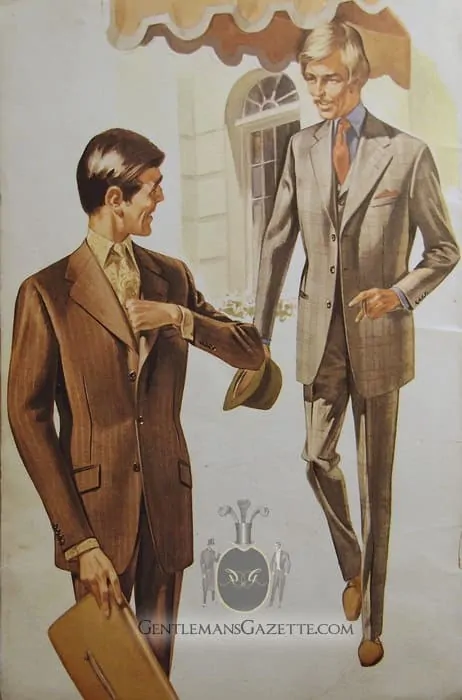
At that same vein, sport coats with bolder patterns seem to be favored for more muted ones. A good glimpse of the style of the ’60s can be seen in this series Mad Men, where you can see, for example, people wearing bold plaid coats, slim suits to the office. The style definitely came to halt in the 1970s which can be considered to be a low point in the history of the suit and men’s fashion, in general.
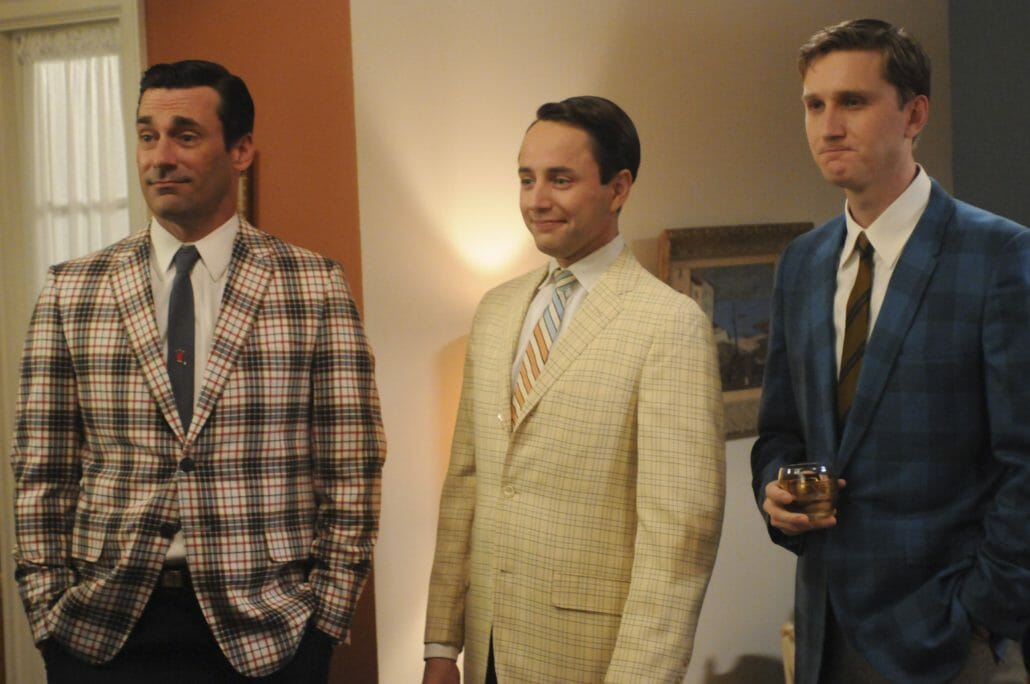
The 1970s
Suits were still relatively tight but had really big lapels, they were rather flashy, and pants oftentimes in a flare cut. Interestingly, the ’70s sort of returned the three-piece suit but it wasn’t formal at all. It was rather casual and more part of the disco culture. Just think of John Travolta in Saturday Night Fever. Along with the bright colors, synthetics were now predominantly used in the 1970s suits which didn’t make them better in the long term and just overall, it was a decade to be forgotten.
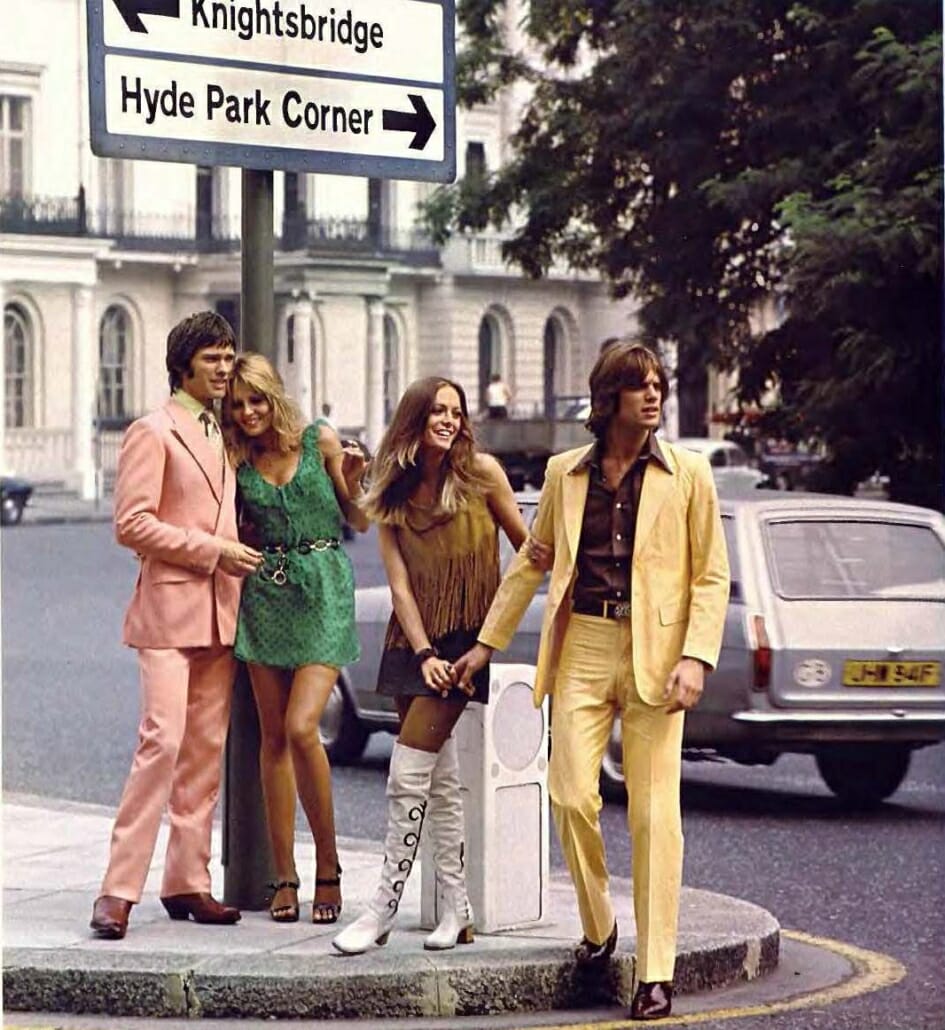
The 1980s
The ’80s, on the other hand, were a lot better for the suit. If we had to break it down to one thing, it would probably be the power suit. It was popularized first by Richard Gere in American Gigolo but also on TV by Miami Vice. The central figure in this suit silhouette was Giorgio Armani. The Italian had a suit jacket that was soft yet broad in the shoulders, had wider lapels with a much lower gorge yet a very very little buttoning point. Overall, Armani created a very defining suit silhouette but today, it is easily dated as the 1980s because of that.
Another great example of the power suit was the stuff that Michael Douglas wore is Gordon Gekko in the film Wall Street. All of those suits were designed by Alan Flusser, and they’re the epitome of what a power suit is to this day. In short, you saw the return of the double-breasted suit, you saw pinstripes again and full-cut pants.
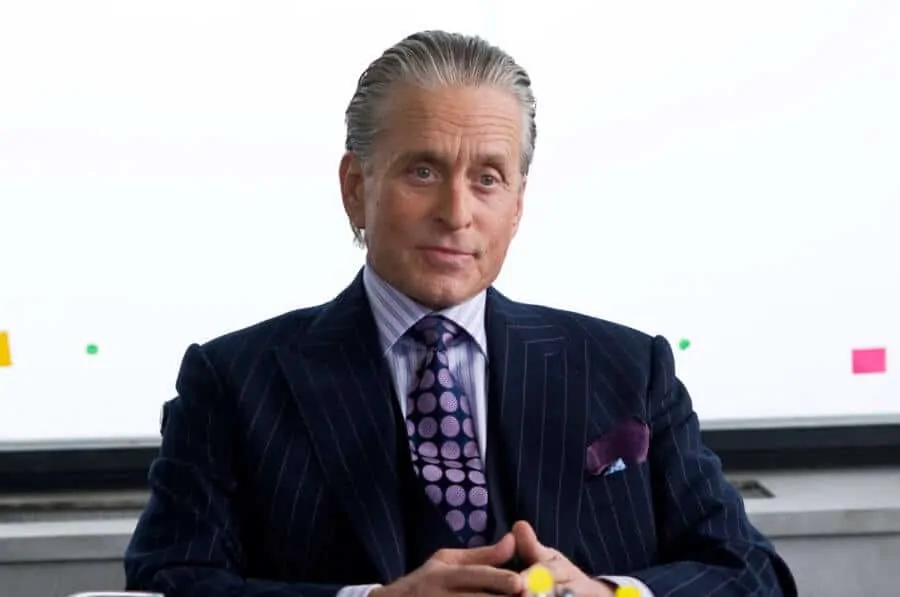
Despite the fact that Armani essentially reduced the structure of the suit and made it very soft, it was still considered to be something that had strong or large shoulders and a defiant silhouette. In general, the ’80s were a time of excess and a celebration of capitalism and the power suit was a direct expression of that time.
The 1990s
The next decade is another low point of the suit. They basically took the worst aspects of the ’80s suits, pronounced it, made it even more ugly. The ’90s suit was more clownish; single breasted jackets sometimes had three or even four buttons, double-breasted ones had six buttons but only the very bottom one was buttoned on an extremely low buttoning point so just the proportions looked off. Pants were boxy and baggy and were too long and puddled around the ankles.
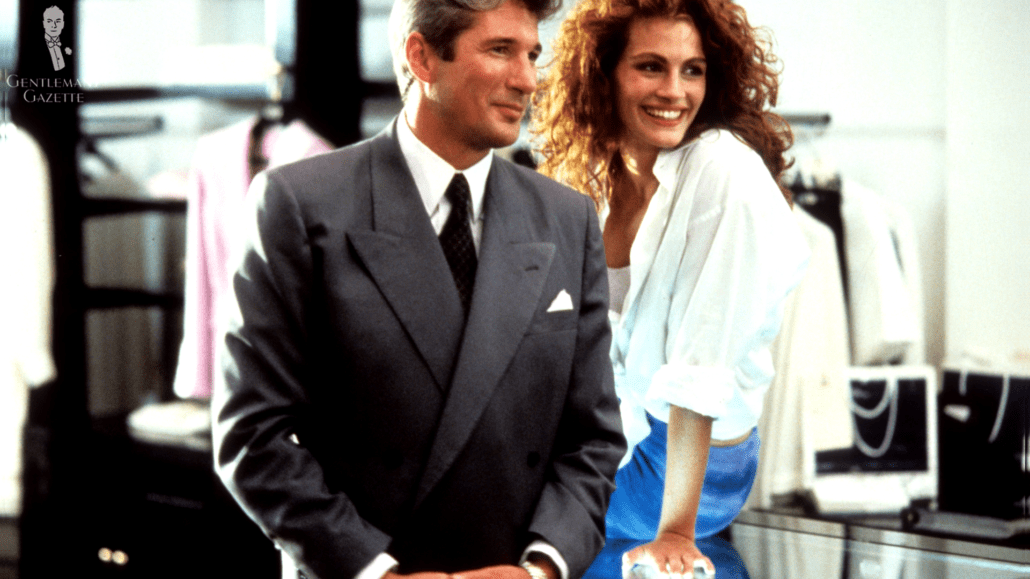
The New Millennium
The 2000s
In contrast to that, the early 2000s saw the return of the slim-fit suit. The new millennium brought a total reaction to the fully cut, puddling suits of the ’80s and ’90s, and went back more to a minimalist style that we had seen before in the ’40s. Some would even argue that it went back more to a 1960s mod-style suit.
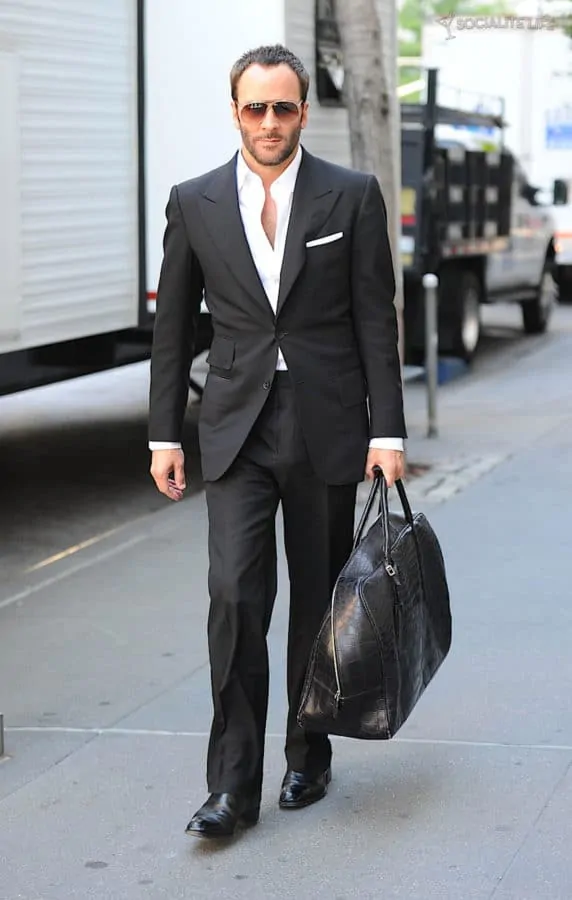
Not only did the suit get slimmer but it also got shorter and the buttoning point got higher. At the same time, some people preferred to wear the black suit as an easy way to create a minimalist uniform that was reduced. Pants were often hemmed quite short, jackets had narrow lapels, and a perfect example of that is Thom Browne, who made extremely short jackets and pants. Others like Tom Ford, for example, had still slimmer cut suits, but they weren’t as extreme. Because of that, Tom Ford suits can still be worn today, whereas Thom Browne suits are more a fashion statement than something a regular man would wear in an everyday setting.
The 2010s
In the following decade, society, in general, became more casual and the need for a suit really disappeared. At the same time, there has been a resurgence in classic men’s clothing of people who don’t have to wear a suit but who intentionally want to wear a suit, because they like the look of it and how it makes them feel.
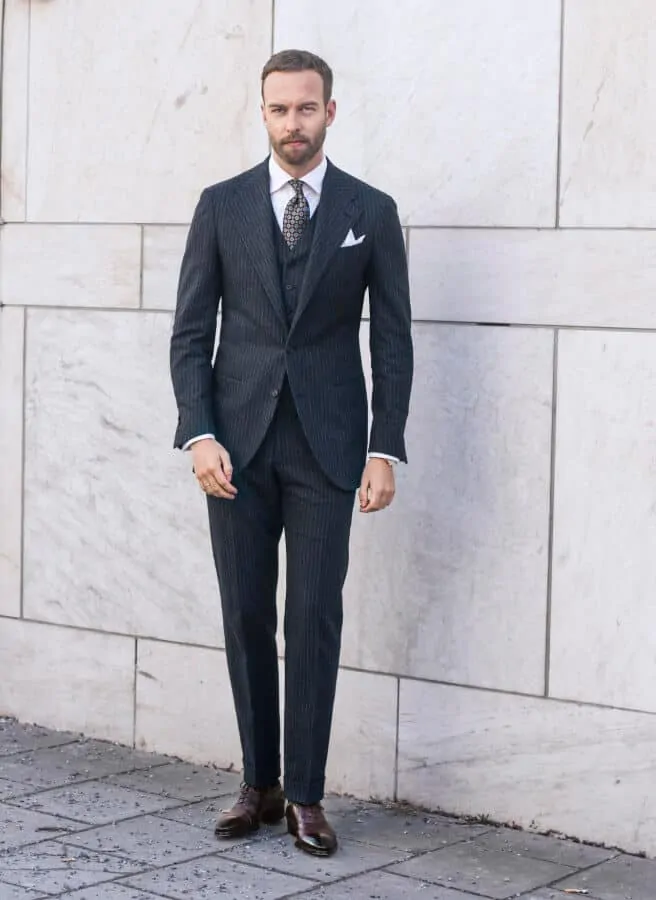
While popular suits, in general, are still slim, the gorge on the jacket has moved further up especially for peak lapel jackets and the buttoning point has come up also. Sometimes, the jackets have even gotten shorter to the extent where they don’t even cover part of your bum anymore. Suit Supply became a worldwide phenomenon reflecting this trend towards a slimmer shorter jacket, higher buttoning point suit. Likewise, Internet technology enabled all entrepreneurs to come up with online made-to-measure services so people can customize their suit online without the need of having to see a tailor.
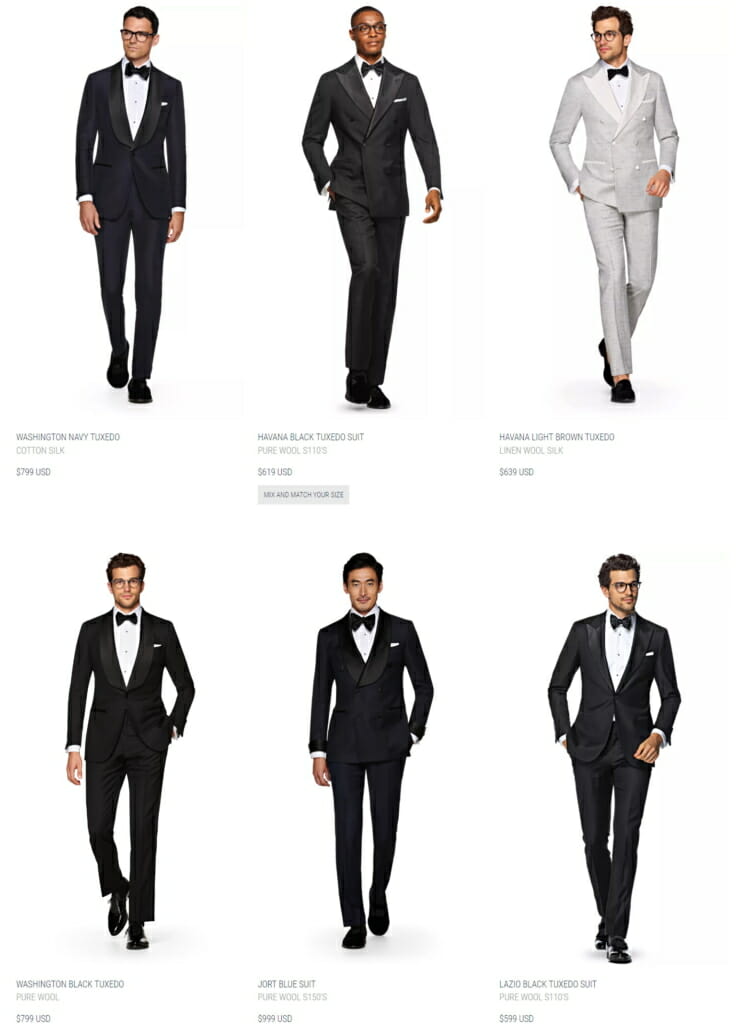
Conclusion – The Suit Today
Nevertheless, with the general resurgence and interest in the topic of suits and classic menswear, there are probably more bespoke tailors today than there were 20 years ago. Thanks to the Internet, interest groups from all across the world can now connect, share, and drop their knowledge and so the general knowledge about the suit and classic men’s style has definitely increased.
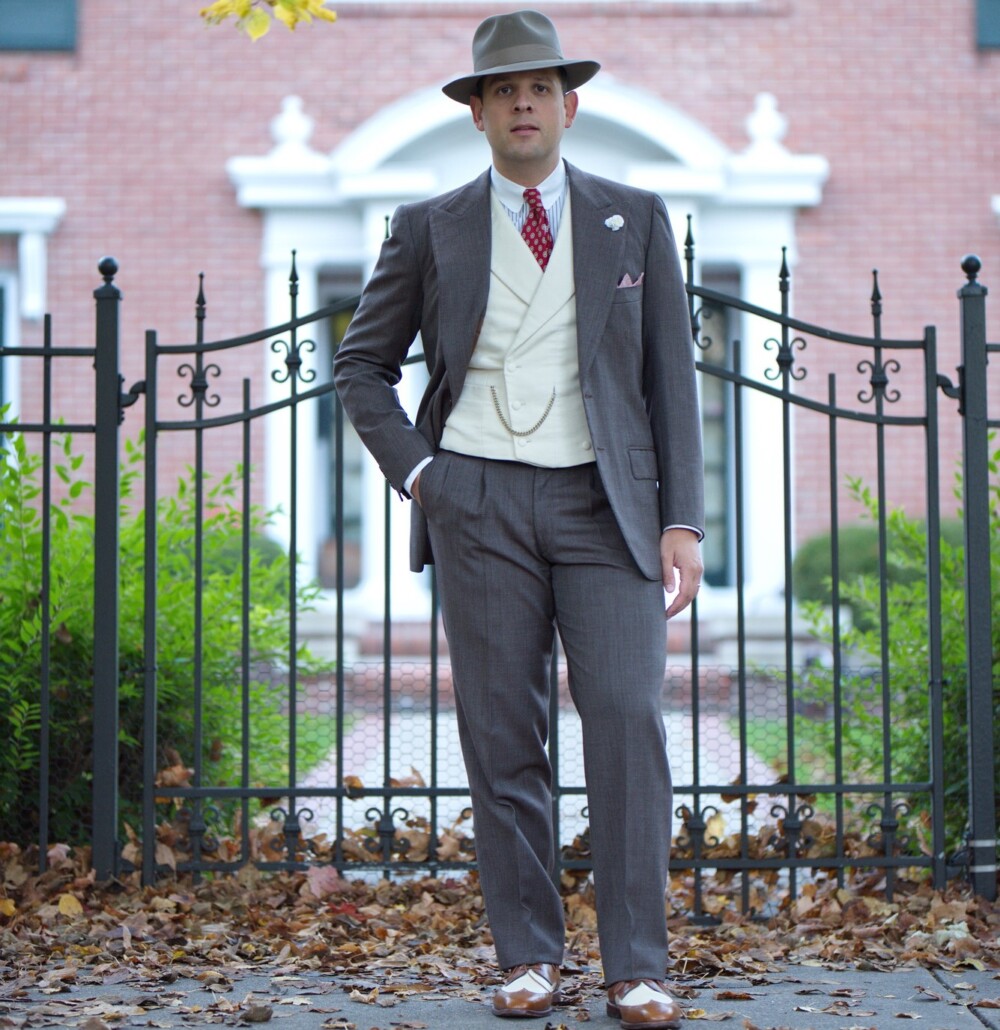
In most recent years, the casual three-roll-two jacket with more natural shoulders in a slim silhouette and sometimes even string trousers have become more popular, so it’s all about getting more casual with more texture and brighter colors in a jacket that is soft and unstructured and sometimes, even made out of a knit fabric which is extremely flexible and feels more like wearing a sweater rather than a traditional suit jacket.
Outfit Rundown
I’m wearing a dark blue double-breasted suit made out of a very fine worsted wool fabric from Vitale Barberis Canonico. It’s a custom suit and it’s extremely soft in the shoulders. In the fabric, it really feels more like a sweater than anything else. Because it’s such a fine high twisted yarn, it is prone to wrinkles. At the same time, I can steam it out in the shower.
I am combining it with a double cuffed summer shirt in bolder stripes of white, yellow, blue, and brown, and a yellow silk knit tie from Fort Belvedere that matches the linen pocket square with cross stitches and of contrasting blue which pick up the color in the outfit.
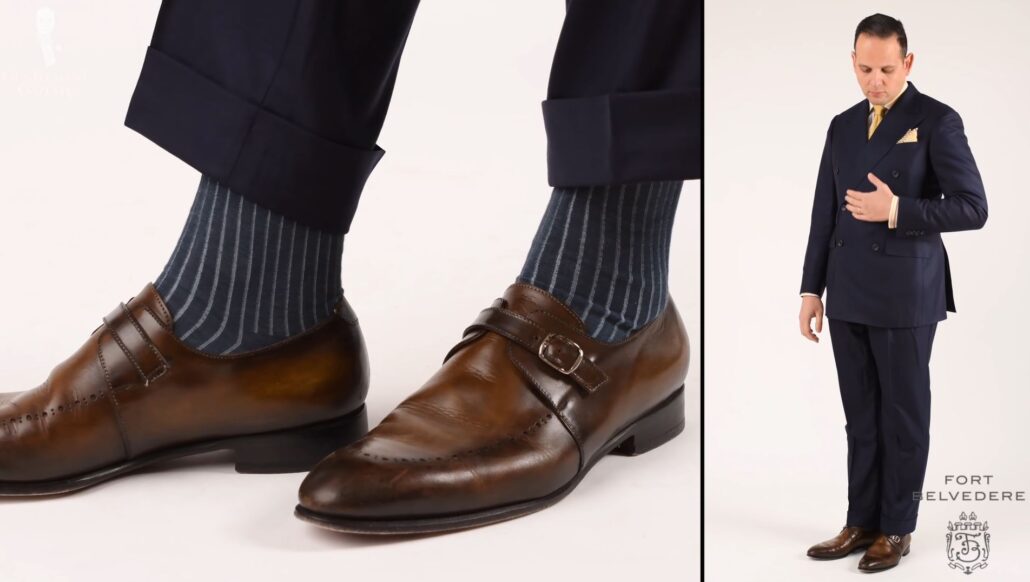
My shoes are hand patinaed Brown monk straps that have a nice color gradation between yellow, brownish light brown, and darker browns, and I’m tying it together with a suit using a pair of shadow striped socks from Fort Belvedere in blue and greyish blue. My cufflinks are gold monkey fists from Fort Belvedere.
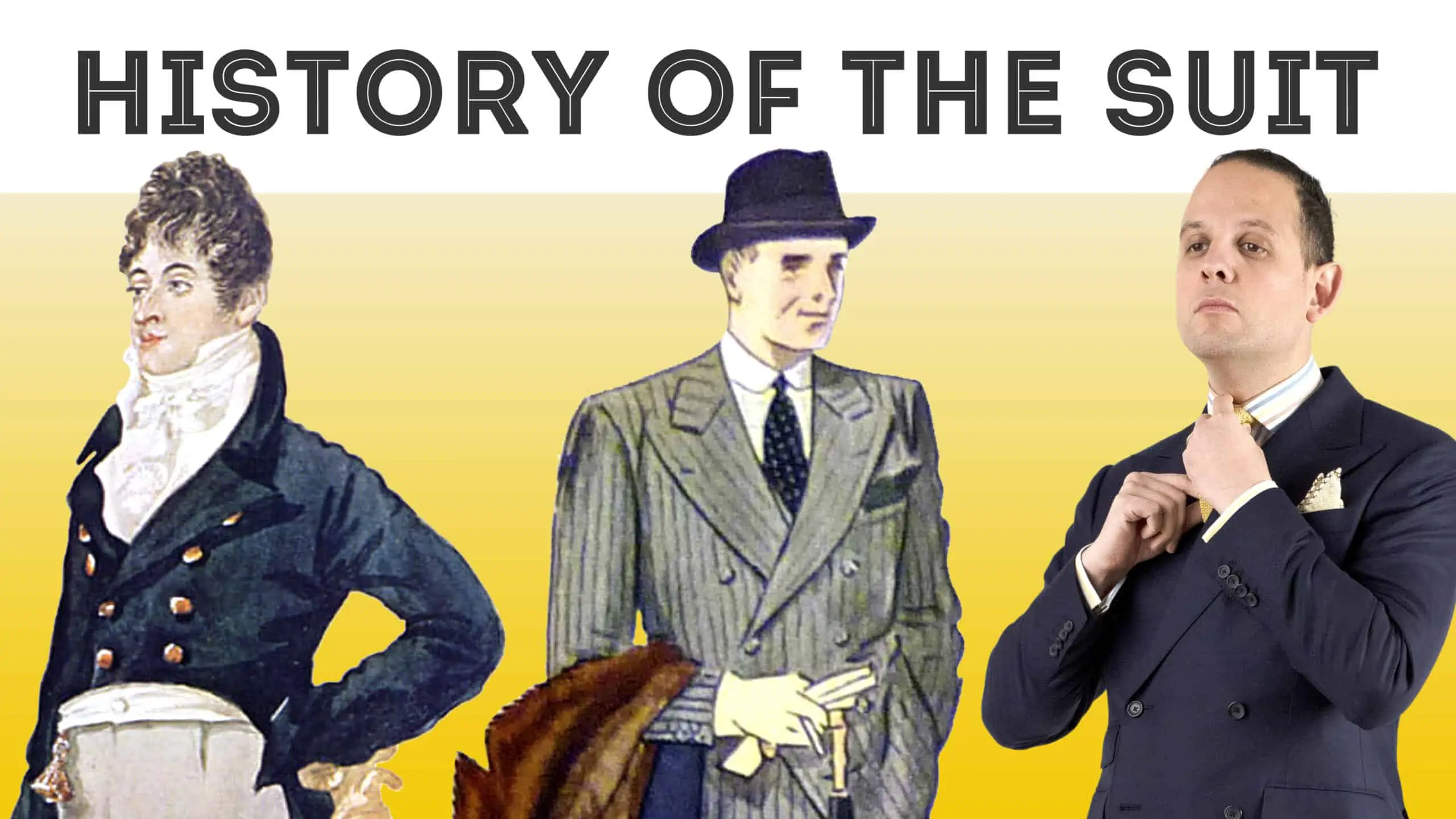
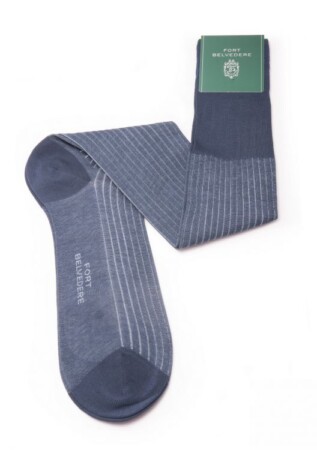
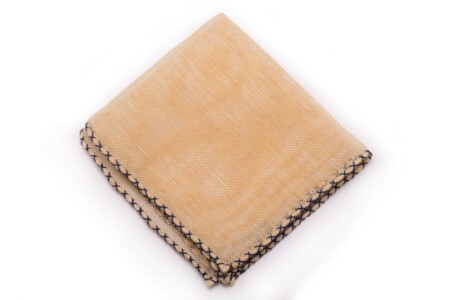
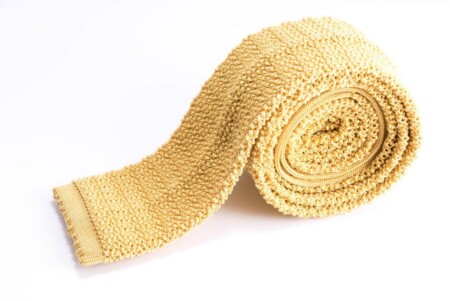
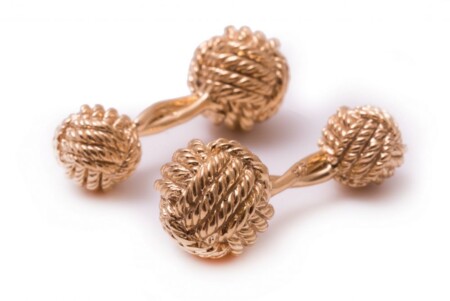
Another great article, delightful indeed. Thanks.
Thank you, Juan!
A really great and insightful article that gives a good overview of menswear’s history. Thank you very much for that.
I might add one detail: the end of the 70’s and beginning of the 80’s were actually a quite remarkable time frame in terms of suits: with the clownish bell-bottoms and large lapels disappearing but still before the now equally clownish power suit, there was actually a time when suits had a really decent and equilibrated cut with medium large lapels, straight cut pants, while still keeping the waistcoats and the overall slim but long sillouette of the coat stemming from the 70’s. At least I could say so about all suits dating from this era I could find in thrift shops so far (or as seen in movies and shows), and if I had to name any as a reference for how a suit should look like, it would be that.
Raphael,
Maybe your best post yet. I see you’re still working on your “Four-In-Hand” (Half Windsor?) knot. Close, but no cigar yet.
On a six button DB, don’t button bottom button. Overall, your posts are top drawer….
Preston should celebrate his slim physique and ware his jackets and vests more fitted. In this day in age, too many gentlemen can only aspire…
All the best,
James I. Laursen
Laursen: Are you talking about Raphael’s double breasted vest, and saying for him to NOT button the bottom button? That would not only be ridiculous but wrong. However, I think that Raphael is stretching the boundaries some by pairing brown and white spectators with a cream double breasted, formal style vest. Perhaps a pair of black patents would do with spats.
SuitsMe,
It took me awhile to catch up to this…Your comment on Ralphael’s vest is correct and I stand corrected. Thank you.
Maybe I was thinking of the traditional 6/2 DB jacket ???
I am getting to age where I sometimes forget how to tie my shoes in the morning after an evening of Balvenie Doublewood and good cigars.
Best/JL
Great article, I’ve been looking for a summarized evolution of menswear in the 20th century, for a while. I would even love it if you made a full video series of videos analyzing formal wear trends and variations in separate videos, also if they are not too long. My only complaint with this one would be on the early History, by giving too much weight to Brummell. Looking at 18th-century portraits of bourgeois and higher-class men, it is clear that there was already a tendency towards a less extravagant style even before the French Revolution. Court dressing and military uniforms did remain quite extravagant, even after Brummell. Still, between the 1730s and 1750s, there had already been a trend favoring sober dark, brown, and grey suits matching the justacorps and the breeches, while leaving the color and flamboyance to the waistcoat. Interestingly, even at this time, this trend seems to have been more prominent in Britain.
khijuouenmirxdfnfqfpnmnovxbxmv
stcuszmorptaaowxwfmyjfsslqmjoa
I would say that no one wore a suit like Robert Stack on Unsolved Mysteries, although I remember someone saying he resembled a detective from a previous era. 1930’s or 1950’s?
Thank you so much. I was doing research for my Art project and this article is the best by far…
Thanks for sharing. Glad we could help!